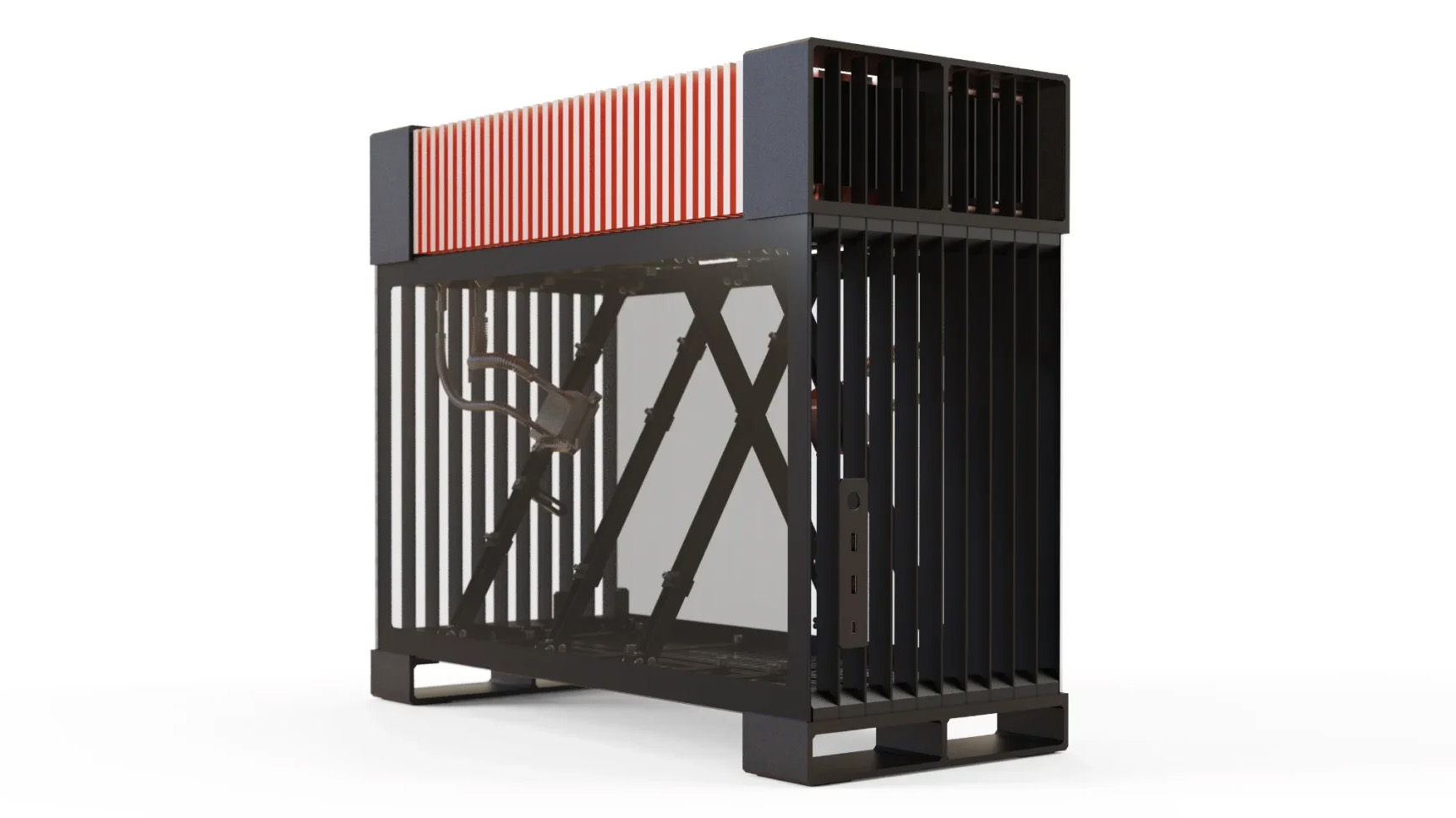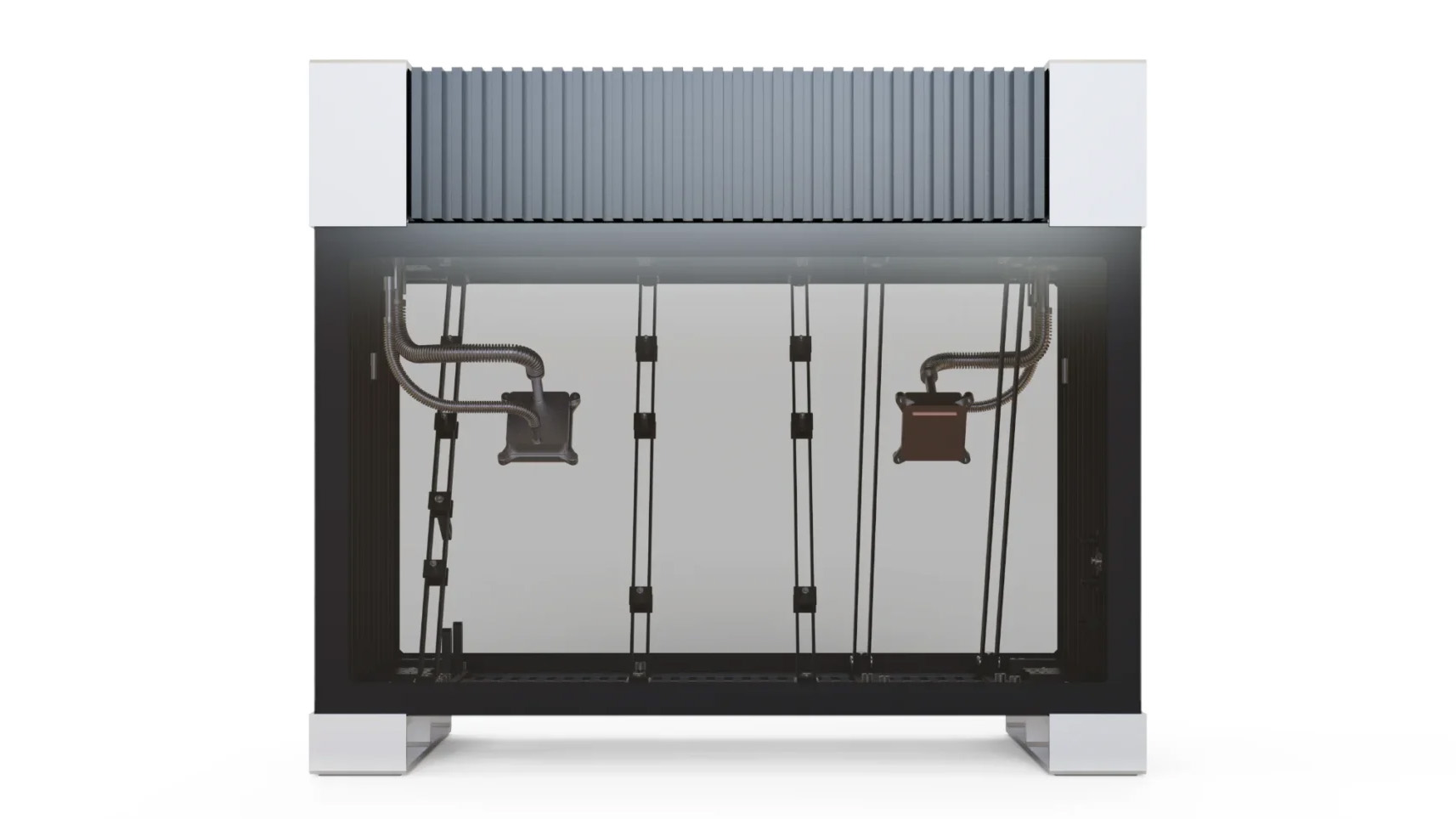Streacom's new $1,300 ultra high-end passively cooled PC case cools up to 600W of power
If that's not enough, you can add several 120mm fans to boost the chassis' cooling performance even further.

Streacom has announced an all-new passively cooled PC chassis called the SG10, capable of cooling up to 600W worth of thermal power. The case was originally unveiled at Computex 2023 as a prototype but is now a finished product ready for production. Pre-orders will begin shortly, with shipping dates of the first SG10 batches estimated to go out as soon as May 2024. Streacom will build two variants: a standard variant featuring an aluminum heatsink and a Copper Edition variant that will be available first to backers of the project. Only 500 Copper Editions units will be produced.
The SG10 is the most aggressive case Streacom has ever made performance-wise, dissipating an impressive 600W of power without the aid of cooling fans. To do this, Streacom invented a new solid-state heat-pipe cooling system that it claims is more efficient than traditional heatpipe designs. The first part of the system is a uniquely designed loop heat pipe system that enables phase changes to occur in a continuous flow around the loop. This differs from traditional heatpipe designs, where phase changes occur in opposite directions within the tube.
Next is the Evaporator component, which helps boost the heat pipe's cooling capability. It features a patented solid-state capillary pump that pressurizes gasses going into the condenser. The pressurized effect is similar to turbocharging an engine, only in this case, it is improving the heat extraction of the cooling loop instead of making horsepower.
Cooling is split into two cooling units (or condensers); the first condenser is dedicated to the CPU, while the other is dedicated entirely to the GPU. Alternatively, if you're building a dual-PC system in this case, the GPU condenser can be re-purposed to cool the CPU in the second system. If the 600W of cooling power is still insufficient, Streacom has gone the extra mile and added an optional rail system that allows 120mm fans to be mounted to the bottom of each condenser — boosting the SG10's cooling capabilities beyond 600W.
Speaking of build options, another highlight of the SG10 is its modularity. The SG10 features a fully modular bracket system that allows the motherboard(s) and/or graphics card to be moved up or down on rails to accommodate the needs of different builds. The case officially supports Full ATX, Standard ATX, Micro-ATX, and Mini-ITX motherboards.
Due to its huge passive cooling system and the addition of its rail system, the SG10 features a unique layout that doesn't feature a mid-plate at all. Every single component in the chassis is effectively visible from all sides of the case, including the right side. The motherboard and graphics card are mounted in an angled position, with the motherboard facing the left side panel and the graphics card facing the right direction. This design enables the condensers at the top to grab as much cool air as possible from the chassis down below without much obstruction. The front and rear of the case have virtually no solid panels to speak of. The only material making up the front and rear "panels" is a series of metal pillars that support the chassis.
The SG10 is a case designed for extremely high-end builds and for enthusiasts who love the idea of a completely silent system. The Copper Edition (if you can get your hands on one) will cost a whopping £1200 ($1,300 USD), while the standard version will cost £1000 ($1,100 USD). Again, availability won't be ready until 2024.
Get Tom's Hardware's best news and in-depth reviews, straight to your inbox.

Aaron Klotz is a contributing writer for Tom’s Hardware, covering news related to computer hardware such as CPUs, and graphics cards.
-
bit_user I don't consider that a heat pipe. If it's a closed-loop and includes a pump, then it's really just a phase-change cooling system like air conditioners use.Reply
It would be interesting to hear more about the "patented solid-state capillary pump".
As for the open front & back, you'd better hope there's no coil whine from the CPU motherboard, GPU, or PSU.
Seems like the top must be open, too. Looks like a bit of a dust trap, though obviously not as bad as if you had active airflow. -
bit_user Here are pics from the CES 2023 article. IMO, they should've been included in this article - otherwise, it's hard to appreciate what they mean about the motherboard and GPU being angled.Reply
Also, that gives a sense of scale. Seems pretty huge, with that guy standing next to it. -
thestryker I really like this concept as it's the first passive cooling design I've seen that can cool a lot but doesn't weigh a ton (16kg). They do split the CPU (250W) and GPU (350W) so while it's 600W I feel like that's an important distinction. I don't think I could ever justify the cost (maybe lottery or other windfall!) but it's really fascinating just the same.Reply
It's a loop heat pipe which I had to look up when it was covered at Computex because I didn't know the terminology and it had seemed like it was just a closed loop to me.bit_user said:I don't consider that a heat pipe. If it's a closed-loop and includes a pump, then it's really just a phase-change cooling system like air conditioners use.
Unless someone cuts open the evaporator I doubt we'll find out much more. I couldn't find the patent information from Calyos, but they have this on their website: https://www.calyos-tm.com/technologies/loop-heat-pipesbit_user said:It would be interesting to hear more about the "patented solid-state capillary pump".
Definitely a big concern since you'd most likely want this case on display. It should be fairly avoidable on the CPU/PSU side as generally you can buy your way out there barring some failed design. I'd be pretty worried about video card though because coil whine seems really random to the point where you wouldn't know until you had it.bit_user said:As for the open front & back, you'd better hope there's no coil whine from the CPU, GPU, or PSU.
L 605mm H 520mm W 268mmbit_user said:Also, that gives a sense of scale. Seems pretty huge, with that guy standing next to it.
So it's basically mid tower height, between a mid tower and dual chamber width and full tower depth. -
MeeLee The nice thing about these cases, is that with 2x simple 140 to 180mm, 12V case fans running at 5V, you can increase the cooling capabilities by at least another 300 to 500W.Reply -
bit_user Reply
Okay, if the "pump" is a completely passive structure, then perhaps I stand corrected. I still think not accurate to call it a "heat pipe", as that implies 2-directional flow. I'd rather call it a "passive, phase-change heat loop".thestryker said:It's a loop heat pipe which I had to look up when it was covered at Computex because I didn't know the terminology and it had seemed like it was just a closed loop to me.
Unless someone cuts open the evaporator I doubt we'll find out much more. I couldn't find the patent information from Calyos, but they have this on their website: https://www.calyos-tm.com/technologies/loop-heat-pipes
An example of a small mid-tower case is: 451 x 431 x 197 (without feet or protrusions). Compared to that, it's 34% longer, 20% taller, 36% wider. I expect it would give the impression of a large mid-tower case. Where they seem to save space vs. a conventional case is by eliminating the drive cage (as far as I can see). With a drive cage, I do believe it'd be huge.thestryker said:L 605mm H 520mm W 268mm
So it's basically mid tower height, between a mid tower and dual chamber width and full tower depth.
BTW, I'd be a little concerned about SSD temperatures. A decent PCIe 4.0 NVMe drive can crank out a fair amount of heat. You'd want to put something in it that's on the efficient end of the spectrum, and then mount a big, passive heatsink on it. -
thestryker Reply
Supports 3x 3.5 or 6x 2.5 (is expandable) and from the pictures they seem to have brackets which mount in the bottom.bit_user said:Where they seem to save space vs. a conventional case is by eliminating the drive cage (as far as I can see). With a drive cage, I do believe it'd be huge.
You wouldn't necessarily need anything efficient, but you'd absolutely need a big heatsink on it. @Albert.Thomas has tested a bunch of SSD heatsinks over here https://www.boringtextreviews.com/ which is a great resource for them.bit_user said:BTW, I'd be a little concerned about SSD temperatures. A decent PCIe 4.0 NVMe drive can crank out a fair amount of heat. You'd want to put something in it that's on the efficient end of the spectrum, and then mount a big, passive heatsink on it. -
bit_user Reply
Oh, and I forgot about the sizzling noise from the heat loop, itself. As the working fluid boils, it tends to make a bit of noise.thestryker said:I'd be pretty worried about video card though because coil whine seems really random to the point where you wouldn't know until you had it.
I knew a guy who had a fanless notebook PC. He got it with the hope it'd be perfectly silent. Instead, what you'd hear was fizzling and popping from within the heat pipes. -
Albert.Thomas I would love to test something like this.Reply
I really like Cooler Master's Cooling X Pre-built, which is somewhat similar, but it's a pre-built with a $7000 price tag -
Albert.Thomas Reply
Just keep in mind that these tests are done under extreme workloads. For common users just loading basic apps and gaming, even the most basic heatsinks will be fine. Only folks who run storage intensive workloads will have need of a strong heatsink.thestryker said:You wouldn't necessarily need anything efficient, but you'd absolutely need a big heatsink on it. @Albert.Thomas has tested a bunch of SSD heatsinks over here https://www.boringtextreviews.com/ which is a great resource for them.

